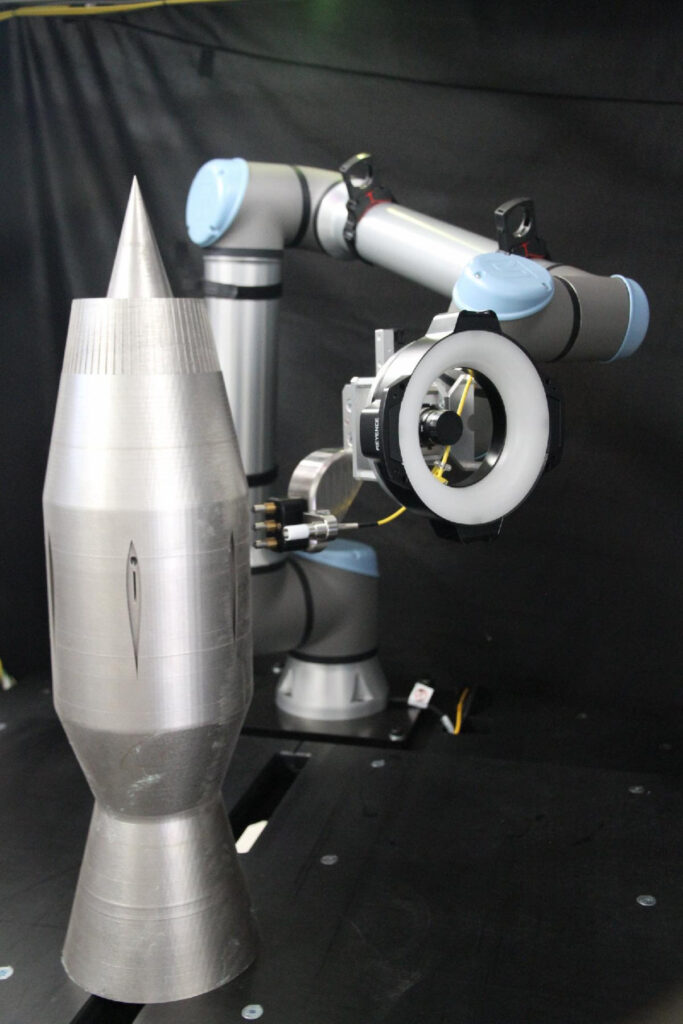3D Printed Ramjet Created by Lockheed Martin and Velo3D
To bring hypersonics to reality, we require either materials that surpass the performance of those NASA and other organizations developed in the 1970s, or innovative ways to utilize these existing materials. The extreme heat and pressure to which hypersonic vehicles will be subjected further emphasize the necessity for optimized, weight-saving 3D printed structures. These must be combined with high-performance 3D printed metals and ceramics to meet the challenging conditions. For all of these reasons, the Department of Defense’s Lightweight Innovations For Tomorrow (LIFT) Institute collaborated with Velo3D, Lockheed Martin, and Vibrant, a non-destructive testing firm, to advance the development of 3D printed hypersonic propulsion systems.
Lockheed played a pivotal role in this area as a prime contractor, proposing a 3D printed ramjet engine designed to evolve into a scramjet engine. Lockheed conducted a design of experiments project using powder bed fusion with Inconel 718 material, before 3D printing two 751-mm tall ramjet engines on a Velo3D Sapphire 1 MZ machine. These components were engineered with exceedingly thin walls, punctuated by 500-micron holes. Subsequent tests on these parts and related coupons provided insights into system reliability and variability between machines.
“AM is a relatively new manufacturing process and there’s a need to validate and certify parts for service and mission-critical applications. We need a data-driven approach to test and certify components right out of a printer, as opposed to a statistically driven one where you have to build multiple parts first and only then gather statistical performance data (make-and-break). Our goal was to identify the signatures of physical quality found in process data and rapid post-process inspection for accurately certifying a component for the rigors of hypersonic flight,” said LIFT Engineering Director Dr. John Keogh .
The team employed Vibrant’s Process-Compensated Resonance Testing (PCRT) to evaluate the components. This rapid, non-destructive method uses a component’s natural resonance frequency to check for cracks, occlusions, proper porosity, and overall build quality. Resonance data is subsequently integrated with in-situ monitoring. This combined information is then analyzed to fine-tune optimal machine parameters.
¨When you’re traveling at Mach 5 or above, you have very high heating at the leading edges. Sharp radii are particularly bad and lead to incredible heating, which is why reentry vehicles from space have reasonably wide radii. But hypersonic vehicles need some semblance of a leading edge for aerodynamic purposes—and there are incredible forces that are compounding and dynamic at hypersonic speeds. It’s a confluence of aerodynamics, mechanics, thermal management, and chemistry that leads to all kinds of interesting and overlapping challenges that are fun to address. And you have to work with extremely high-temperature materials that survive these environments,” Keogh added.
Managed by LIFT, this effort is part of a larger partnership with the American Lightweight Materials Manufacturing Innovation Institute, a member of the Manufacturing USA network. With a budget exceeding $100 million and a diverse membership of over 300 academics and firms, LIFT is also known for partnering on MELD’s jointless vehicle hull project. Another significant initiative from the institute is the Hypersonics Challenge, conducted on behalf of the Department of Defense’s Office of the Under Secretary of Defense for Research and Engineering. The project focuses on identifying materials and manufacturing methods conducive to creating components for hypersonic vehicles.
The team aims to leverage this data, along with further experiments, to accurately predict and assess the elusive fatigue properties of 3D-printed parts. The ultimate goal is to produce components that are “born certified,” emerging from the machine already meeting quality standards. Given the intricate challenges posed by hypersonics, success will require extensive collaboration. Hypersonics is, by its nature, a team endeavor, as the obstacles are too formidable for any single firm to overcome alone. This technology represents the ultimate high ground, poised to significantly influence global power dynamics in the future. So this initiative serves as an excellent beginning, and we anticipate seeing many more such collaborative projects in the pipeline.
Subscribe to Our Email Newsletter
Stay up-to-date on all the latest news from the 3D printing industry and receive information and offers from third party vendors.
Print Services
You May Also Like
New Business: Temporary, Migratory, & Modular 3D Printed Architecture
If we look at potentially emerging 3D printing businesses, then architecture has not been fully explored. Yes, there is a lot of house 3D printing going on worldwide. From deployable...
3D Printing News Briefs, April 19, 2025: Material Extrusion Standard, Metal Powder, & More
In today’s 3D Printing News Briefs, we’re covering a proposed standard for material extrusion, before moving on to business and metal powder. We’ll end with a commercial store’s robotic 3D...
Japan Unveils World’s First 3D Printed Train Station
Japan is now home to what we believe is the world’s first train station built with 3D printing technology. Located in Arida City, just south of Osaka, the new Hatsushima...
restor3d Raises $38M to Expand 3D Printed Orthopedic Implants
Backed by $38 million in new funding, restor3d is pushing ahead with the launch of four personalized implant lines, set to roll out in 2025 and 2026. This latest venture...



























